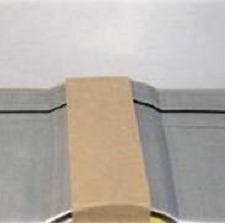Cut and Stack Labeling Nightmares Part I
May 26, 2015
Ever wake-up in a cold sweat worrying about the runnability of your cut and stack labels?
Likely not… but runnability issues are definitely something that can cause some serious frustration when it happens. And if you do happen to be that unlucky soul worrying about your label runnability – fear no-more my friend!
At Inland we know how important it is to keep your labels running smoothly on the line – as it’s a matter of consistency, efficiency and consumer satisfaction. So to help put an end to cut and stack labeling fears, we’ve decided to help you face them head-on with our best survival tactics.
Curl
Curl is when your labels have a bent profile when loaded into the label basket. Label curl can originate as far back as the paper manufacturer with a possible defect in the label material itself. However, it can also be caused by label provider error, such as improper packaging or bundling. Another possible cause of label curl is the difference between relative humidity in the paper and in the plant (whether that’s the label manufacturer’s plant or your own).
Be sure that your label provider is producing in a controlled environment. For example, we monitor relative humidity and temperature in our plants so that curl is avoided in any paper supply. The same should be true in your operating environment. If you know the humidity or temperatures are varying on your label line, it helps to keep labels in a clean, dry area off of the floor at about 70-90 degrees Fahrenheit (sounds cozy) and 45-55% humidity. Staging your labels in this type of an environment for at least 24 hours before running them at your facility lessens the likelihood of curl.
Flagging
Ever notice labels bending back from or off of the container after exiting the labeler’s discharge star (you know, that piece of equipment that moves the labeled container onto the conveyor belt)? This is what we call label flagging. This can happen when a paper is too stiff or heavy for label design. However, flagging can also be the result of improper brush-down of the label, paper and adhesive miss-match or defective backside coating on paper. It could also go back to the manufacturing of the container. For example a glass container that has excessive cold-end treatment (the coating that is applied to the glass to add some slipperiness to the bottles so that they won’t break as they bump into one another down the filling lines) makes the label difficult to adhere to the container.
First steps to managing label flagging are usually adjusting your current brushes or adhesives to see if that solves the problem. If not, it may involve changing the adhesives or label paper all together as a long-term solution – such as down-gauging your paper stock. While label flagging can be caused by a variety of issues, your label provider should be able to help troubleshoot and determine the most efficient solutions for your manufacturing lines.
Size Variation
One cut and one opportunity to get it right. If you’re seeing unacceptable or out-of-spec size differences in-between your bundles – or even within your bundles – this is a size variation issue. Normal variation between jobs can occur, so it’s important that you and your label provider set cut tolerances up-front (+/-.015” is usually the standard). The cause of out-of-spec size variation, however, could be something as simple has human flaw on the label provider side. It may also be an equipment error. For example, an over-used or worn label die may be allowing out-of-spec cuts.
To verify that the labels are indeed out of spec, be sure to send your label provider some label bundles as examples. This will give them a better idea of what the size variation defect is and how it can be solved. If the size variation isn’t out of spec you can always group like-sized labels together in the label basket and adjust the label fingers appropriately to help hold the labels in the basket consistently.
Scuffing
Scuffing refers to any surface damage to the label during or after application to the container. What may seem like a fairly simple problem can actually be the result of various labeling mishaps. Some causes of label scuffing include miss-adjusted conveyor rails, container-to-container contact on the line, no label panel on the container or excessive moisture or adhesive on the label line. Scuffing can also occur when a container is taken off the line and placed into packaging or cases. On the label provider side scuffing may also be the result of an incorrect topcoat or a flaw during the top-coat application.
To eliminate scuffing it may make sense to first look into adjusting your equipment as needed to be sure that the railing or any other machinery in your label line isn’t causing the scuffing. Reducing the amount of moisture on the label line or adhesives in general may also help. If the scuffing continues and your product doesn’t have/has a minimal label panel you may want to consider a deeper label panel in future packaging. As a long-term solution, your label provider may also suggest the use of a higher wet-strength label.
_____
While there’s no one-size-fits-all solution to cut and stack labeling problems, it’s helpful to be armed with the right set of defensive mechanisms.
Worried about another cut and stack labeling dilemma we failed to mention? Check out Part 2 of this series where we’ll face your fear of label tearing, blocking, inversion and poor adhesion.



